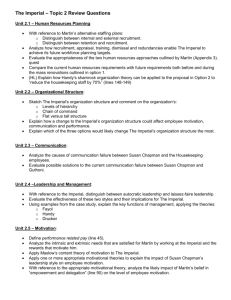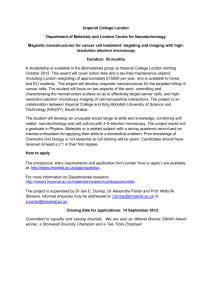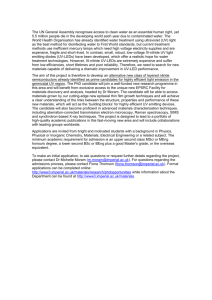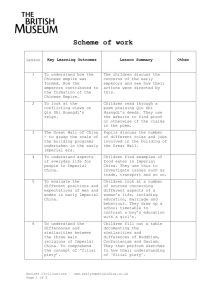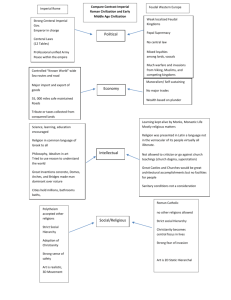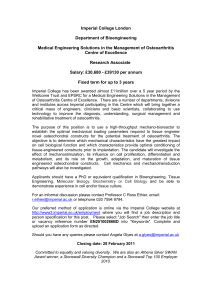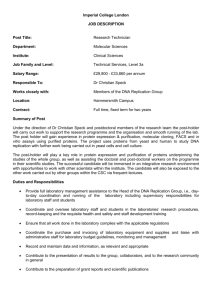IB Business and Management Case Study 2014: The Imperial KEY
advertisement
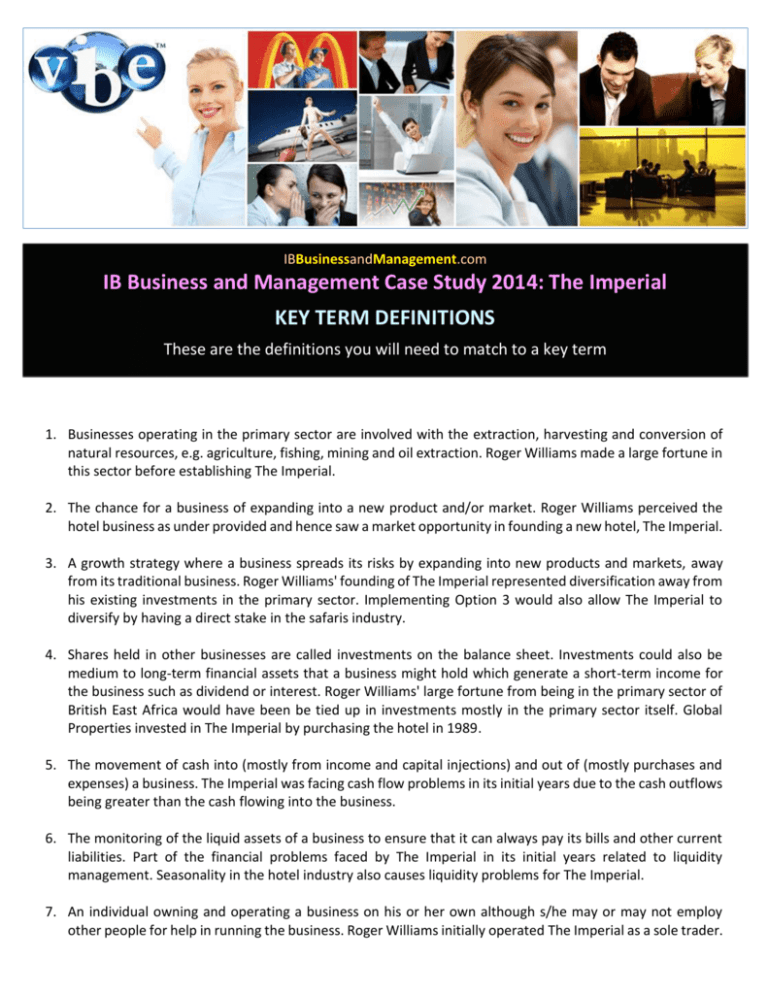
IBBusinessandManagement.com IB Business and Management Case Study 2014: The Imperial KEY TERM DEFINITIONS These are the definitions you will need to match to a key term 1. Businesses operating in the primary sector are involved with the extraction, harvesting and conversion of natural resources, e.g. agriculture, fishing, mining and oil extraction. Roger Williams made a large fortune in this sector before establishing The Imperial. 2. The chance for a business of expanding into a new product and/or market. Roger Williams perceived the hotel business as under provided and hence saw a market opportunity in founding a new hotel, The Imperial. 3. A growth strategy where a business spreads its risks by expanding into new products and markets, away from its traditional business. Roger Williams' founding of The Imperial represented diversification away from his existing investments in the primary sector. Implementing Option 3 would also allow The Imperial to diversify by having a direct stake in the safaris industry. 4. Shares held in other businesses are called investments on the balance sheet. Investments could also be medium to long-term financial assets that a business might hold which generate a short-term income for the business such as dividend or interest. Roger Williams' large fortune from being in the primary sector of British East Africa would have been be tied up in investments mostly in the primary sector itself. Global Properties invested in The Imperial by purchasing the hotel in 1989. 5. The movement of cash into (mostly from income and capital injections) and out of (mostly purchases and expenses) a business. The Imperial was facing cash flow problems in its initial years due to the cash outflows being greater than the cash flowing into the business. 6. The monitoring of the liquid assets of a business to ensure that it can always pay its bills and other current liabilities. Part of the financial problems faced by The Imperial in its initial years related to liquidity management. Seasonality in the hotel industry also causes liquidity problems for The Imperial. 7. An individual owning and operating a business on his or her own although s/he may or may not employ other people for help in running the business. Roger Williams initially operated The Imperial as a sole trader. 8. The view of a company held by its customers, employees and other major stakeholders. The Imperial enjoyed a very positive corporate image initially. 9. Individuals or firms who have put money in the business expecting it to generate a return in the future. The five different owners that The Imperial had from 1959 to 1989 were investors in the business. Global Properties is the investment group that bought The Imperial in 1989. 10. An incorporated business that is owned by shareholders with limited liability but whose shares cannot be offered for sale to the public. The subsidiary set up by GP was incorporated as a private limited company. 11. The trend towards free international trade and free movement of capital between countries resulting in the integration of economic, social, technical and cultural issues of the world's economies. It is largely a consequence of expansion of multinational corporations around the world. GP, an international investment group, with investors from Japan, South Korea and the USA, symbolises globalisation. 12. Shareholders, also known as stockholders, are people who own shares in a private or a public limited company. GP's shareholders were from the United States, Japan and South Korea. 13. People responsible for the day-to-day running of the business or a department within the business. Managers are generally accountable to Directors and responsible for the staff teams they supervise. Martin Kimathi was appointed the Hotel Manager at The Imperial. Susan Chapman is the Head of Housekeeping at the hotel. 14. The surplus left after all costs are deducted from sales revenue. GP expected the Hotel Manager at The Imperial to generate profits for the investment group. 15. The share of the net profits that a company distributes to shareholders. Preference shares usually carry a fixed dividend while ordinary shares a variable dividend depending on the profitability of the company. Most of the profits generated at The Imperial were usually paid back as dividend to GP. 16. The level of output that generates neither any profit nor loss, shown on the x-axis corresponding to the break-even point, where total revenue = total costs. An annual meeting between the Hotel Manager of The Imperial and a representative from GP would calculate the break-even quantity for the following year. 17. The guaranteed minimum level of profit the company must earn to satisfy the shareholders. The Hotel Manager and the representative from GP would meet annually to set target profits for the year ahead. 18. Also referred to as the safety margin, this refers to the difference between a business' current level of production and its break-even level of output (in terms of units of production). A positive safety margin means that The Imperial can face lower sales but still be making a profit. A negative safety margin would indicate The Imperial is making a loss. The Hotel Manager and the representative from Global Properties would meet annually to determine the margin of safety for the year ahead (lines 24-25). 19. The process of hiring a suitable worker which would involve a thorough job analysis involving identifying the need for a new employee, defining the job (Job Specification) and the most appropriate person for it (Person Specification), attracting a number of suitable candidates and then selecting the one most suited to the job. In 2000 when Martin returned to Kenya, The Imperial was recruiting receptionists. 20. Refers to the advancement of an employee in the company hierarchy leading to improved status, more responsibilities and, possibly, increased salary. Martin Kimathi joined The Imperial as a receptionist and was promoted to Head of Reception five years later. 21. A type of internal stakeholder, namely the people who work for a business. They are workers who are employed by The Imperial to carry out specific tasks within the organisation. Most Kenyan employees at The Imperial spoke Kikuyu. 22. Physiological needs are essential things that all human beings must have in order to survive e.g. food, clothing and shelter. Needs appear at the bottom of Maslow's hierarchy of needs. Martin's appointment as Hotel Manager at The Imperial seemed to satisfy most of his needs. 23. Fixed amount of remuneration paid to senior staff usually at the end of the month. They generally represent a fixed cost. Martin was paid a salary based on his position and performance. 24. A bonus or an increase in salary awarded to an employee for his or her achievements over a range of preagreed targets or criteria. These targets can relate to sales targets, competence in a job, successful completion of a contract or any another pre-agreed criteria. Martin Kimathi's salary was based on performance-related pay. 25. Business activities which are intangible but which people are ready to pay for e.g. airlines, tour agents, hotels. The new hotels opening in The Imperial's vicinity were offering better facilities and services than The Imperial. 26. Percentage of all sales in a market that is held by one brand or a business. It can be measured in volume (units sold) or value (revenue generated). The Imperial was facing shrinking market share on account of the opening of new luxurious hotels in Mombasa. 27. A detailed financial plan for the future usually involving a cash flow forecast. Each cost and profit centre may be allocated a budget. Martin was given a limited budget for renovation and improvements every year. 28. Information collected from second hand sources such as government statistics or market research reports, all of which are relatively easy to access. Martin's use of secondary market data from Kenya National Bureau of Statistics and other tools helped him to realize that The Imperial could attract a new type of traveller interested in safaris or in cultural tourism. 29. A systematic examination and review of the current position of a firm's marketing in terms of its strengths and weaknesses as well as where a firm stands in its relationship with customers and competitors. It was used by Martin Kimathi, along with secondary market data, to identify a new market segment of tourists to cater to - the ones interested in safaris or in cultural tourism. 30. Also referred to as perception maps, this is a visual aid used to show customers' perceptions about the product or brand in relation to others in the market, against variables such as price and quality. A position map was used by Martin Kimathi to help him realize the new types of travelers that The Imperial could tap into. 31. Concerns to a business arising from changes in the target market or from the emergence of new competitors leading to issues of market share or product perceptions. The Imperial was facing long term challenges on both the fronts. 32. Also referred to as net current assets, this represents the amount of finance available to a business for its day to day operations. It is calculated using the formula: current assets - current liabilities = working capital Too little working capital would indicate strained liquidity while too much would indicate business conservatism and wasted investment opportunities which could have led to improved efficiency. The seasonal nature of the business had created working capital worries for Martin Kimathi. 33. A period of time in business, generally less than a year. Working capital issues had been a worry for Martin Kimathi in the short term. 34. The effect of seasonal variations on a business. The Imperial was prone to working capital problems on account of the seasonality of its hotel operations. 35. Medium to long-term plans on ways of achieving achieve specific objectives. Martin Kimathi had to design strategies to deal with liquidity problems that The Imperial was facing. 36. Problems arising from an inability of a business to meet its short-term debts, as seen from its liquidity ratio or acid test ratio. Problems in working capital management were creating liquidity problems at The Imperial. 37. A department or a unit of a business that incurs both costs and revenues and hence maintains its own profit and loss account. It allows a business to identify the areas that generate the most and those that generate the least revenue. The accountant recommended to Martin to use profit centres for the hotel itself, the restaurant and the special events services as one way of addressing liquidity problems. 38. A cost centre is a department or a unit of a business which does not generate any revenue yet to which specific costs can be clearly attributed and allocated. It is used as a control tool to make different departments conscious of their costs and to encourage them to operate within their budgets. Martin Kimathi was being encouraged to establish some departments, such as housekeeping, as cost centres. 39. Also called the published accounts, these are the annual financial statements that all limited liability companies are obliged by law to produce and report, namely the Balance Sheet and the Profit and Loss Account. 40. The P&L account is part of the final accounts of a business, which is a financial statement of a business' trading activity over a period of time. It is usually split into three parts: the Trading Account, the Profit and Loss Account and the Appropriation Account. Martin Kimathi was expected by GP to organize the preparation of the Profit and Loss Account for The Imperial. 41. Also part of the final accounts of a business, the balance sheet is a financial statement showing the assets and liabilities of a business at a point in time, usually, the last day of the financial year. In a balance sheet, the sources of funds must be balanced with the uses of funds. Martin Kimathi was expected by GP to organize the preparation of the Balance Sheet for The Imperial. 42. Also called inventories, stocks are physical materials and goods that a business holds for further production or sale. They appear on the Current Assets of the Balance Sheet of a business. At The Imperial, the Head of Catering was unable to manage the actual stocks. 43. Also called Stock Valuation, this refers to the methods used by a business to place a value on stocks. Stock valuation can be influenced by the purchase date and costs of purchase. LIFO and FIFO are the two main methods for stock valuation. At The Imperial, the Head of Catering struggled to make appropriate calculations of closing stock values. 44. Human Resources (74) 45. Human resources are the personnel or the employees of a business, often regarded as an asset for their skills and abilities. Martin had a human resources problem in terms of his strained working relationship with Susan Chapman, the Head of Housekeeping. 46. Motivation (78) 47. Motivation is the desire, effort and passion to achieve something. Craig Chapman, Susan's grandfather was driven by humanitarian motivation when he decided to stay back in Kenya after its independence and work for a non-profit organisation. By contrast, Martin Kimathi seems to be motivated by the salary, linked to performance, to meet his own needs. 48. Non-profit organisations (79) 49. Non-profit organisations are private sector organisations that do not primarily aim to make a profit and usually operate for the benefit of others in society. Craig Chapman had humanitarian motivations at heart when he decided to stay in Kenya and work for other non-profit organisations. 50. Discrimination (84) 51. The unjust or prejudiced and biased treatment of different categories of people especially on grounds of age, gender, religion, race or any other reasons. In countries allowing equality and freedom from discrimination as a fundamental right, any acts which seem to imply discrimination are against the law and can be challenged in a court of law. Even three years after Martin's appointment as Hotel Manager of The Imperial, Susan still felt she had been discriminated against. 52. Leadership style (87) 53. Leadership style refers to the way in which managers and leaders choose to behave in relation to how they organize and control their employees. Martin has a laissez-faire style of leadership and preferred to allow his employees to fix minor problems and believed in delegating responsibility and empowering employees to make decisions. Susan has an autocratic style of leadership and likes systems, accountability and a clear chain of command. She focuses on the task rather than the team involved in getting the job done. 54. Task-oriented (87) 55. If people are task-oriented they focus on the task and getting the job done without considering the needs of the team completing the task. They tend to put systems and procedures in place for achieving the goal and these must be strictly adhered to. They do not allow their employees to be creative and make their own decisions and as a result employees can become demotivated. Susan was task-oriented and adopted a very formal approach to management and was intolerant of even minor mistakes. 56. Bureaucracy (88) HL 57. Bureaucracy means that there are many administrative procedures and rules that have to be followed to complete a task. Susan enjoyed bureaucracy (formal policies and procedures) and had created a system of rules, a clear chain of command and system of accountability within the Housekeeping Department to ensure that tasks were completed without mistakes and that all employees were held accountable for their jobs. 58. Chain of command (88) 59. The chain of command refers to the formal line of authority through which orders are passed in an organisation. The structure of the hierarchy is usually presented in an organisation chart. Susan "liked a clear chain of command" (line 88) which means that each employee in the organisation knows to whom they are responsible. The line of authority in the Housekeeping Department ends with Susan. 60. Scientific approach to decision-making (88) 61. A scientific approach to decision-making means that facts are collected and a logical approach is applied to decision-making in contrast to using intuition and experience. Susan had a scientific-approach (line 88) to decision-making and relied on facts and figures as a basis for her decisions. 62. Laissez-faire (90) 63. A laissez-faire leadership style is one in which the leader makes the major decisions and sets the overall objectives for the organisation and subsequently assigns tasks for employees and lets them make decisions and complete tasks as they see fit. Martin had a laissez-faire leadership style (line 90) and he believed in passing on the responsibility for solving minor problems to his employees as he felt it led to empowerment and motivation. 64. Empowerment (90) 65. Empowerment is when authority to carry out a task is passed to an employee and the person feels they are in control of the task and can take decisions. Martin believed in empowerment of his employees and an example of this is that he allowed his employees to solve minor problems even though he could easily fix them himself (line 91). 66. Delegation (90) 67. Delegation occurs when the authority for completing a task is passed to another person. The person to whom the task has been delegated must ensure that it is carried out and they are accountable to their manager for completing the task. The ultimate responsibility for the task remains with the line manager. Martin believed in delegating tasks (line 90) to employees and empowering them to carry them out and to make their own decisions. 68. Selecting (95) 69. Selecting an employee occurs when s/he is chosen from a pool of candidates, during the recruitment process, for a position within an organisation. Martin was selected instead of Susan for the position of Hotel Manager. 70. Autocratic (98) 71. An autocratic leader is one who makes all decisions within an organisation and tells the employees what to do and therefore does not allow them to make decisions for themselves. An autocratic leader does not believe in delegation and empowerment of employees. The employees of the Housekeeping Department considered Susan to be too autocratic (line 98) as she was demanding and did not allow them any flexibility within their role. 72. Informal communication networks (99) 73. An informal communication network is a system which enables transmission of communication between people, for example, through social conversations and gossip (line 99) or in the "grapevine". 74. Informal communication (99) 75. Informal communication is communication that takes place through social conversations and gossip. The employees used informal communication to discuss and exchange examples of Susan's autocratic management style (line 100). 76. Appraisal (102) 77. An appraisal is a formal system of judging a person's performance at work. The process usually consists of collecting data about an employee's performance and contribution to the workplace through observation and an interview with the person being appraised; the interview is conducted by their line manager. Martin had appraisal meetings with Susan but she always avoided a discussion of her management style in these meetings (line 102). 78. Benchmarking (107) HL 79. Benchmarking is when an organisation compares itself or is compared to the industry leader to determine its rank and performance. The French journalist who stayed at The Imperial wrote that in terms of benchmarking the hotel is "tres magnifique" (Line 107) in terms of its housekeeping. 80. Absenteeism (111) 81. Absenteeism occurs when an employee does not attend work. Guthoni was frequently absent from work due to poor health, so was dismissed by Susan for repeated absenteeism (line 111). 82. Dismissal (113) 83. Dismissal occurs when an employee's contract of employment is terminated as they are no longer employed by the organisation, in other words they are fired. Guthoni was dismissed by Susan for repeated absenteeism (line 113). 84. Strike (114) HL 85. A strike is when the employees of an organisation agree to withdraw their labour services for a specified time period. This means that the employees will not perform their usual duties so the organisation will have great difficulty functioning. The employees of The Imperial decided to go on strike in December 2013 (line114). 86. Negotiations (116) HL 87. Negotiations are discussions which take place between two parties in order to resolve an issue. Martin started negotiations with representatives of the employees about their proposed strike action and the underlying reasons for the industrial action (line 116). 88. Employee representatives (117) HL 89. Employee representatives are a small number of workers selected usually by the other workers to present their views to management. The representatives will call a meeting with all employees to determine their opinions before passing on their views to the management. This collective voice tends to be more powerful than people passing on their opinions individually. 90. Responsibility (120) 91. Responsibility occurs when a person is given a task to do which they are required to carry out and be accountable for their actions. The workers seemed to be taking their responsibility for the operations of the hotel far more seriously than before the conflict and proposed industrial action (line 121). 92. Conflict (122) HL 93. A conflict arises when two parties disagree over an issue. The employees of The Imperial disagreed with Susan's decision to dismiss Guthoni from her position in The Housekeeping Department and decided to take industrial action in the form of a strike in December 2013. 94. Change (123) HL 95. Change arises when factors that influence the operations of an organisation do not stay the same. Martin knew he needed the full commitment of all employees as great changes lay ahead for The Imperial (line 124). 96. External environment (125) 97. The external environment refers to the factors beyond the control of the business which have an impact on business operations and performance. They include: political, economic, social, technological, legal, ethical and environmental factors. The Imperial has to adapt to changes in the external environment (line 125). 98. Strategic decisions (125) 99. Strategic decisions are those taken by the business so it can achieve its objectives. They are part of a business' long-term plan. The Imperial needs to take strategic decisions to achieve long term success and adapt to the changes in the external environment in which it operates. 100. Reposition (128) 101. Reposition means to change the perception of a business from the opinion of its customers. This may be achieved by altering the marketing strategy to change the brand image. If Option 1 is adopted the renovation of the hotel will upgrade its image and services on offer and therefore reposition The Imperial to its former place as the premier hotel in Mombasa. 102. Decline phase (130) 103. The decline stage of the product life cycle occurs when the sales of a business start to fall. The Imperial was in the decline stage of its product life cycle. 104. Product life cycle (130) 105. The product life cycle of a business measures sales over time. A typical product life cycle has the following phases: introduction, growth, maturity, and decline. The Imperial is in the decline stage of its product life cycle and therefore the hotel's occupancy rate had fallen. 106. Marketing (134) 107. Marketing is the process through which customers' needs are predicted, identified and satisfied in a profitable way. The marketing process can be broken down into 8 Ps: product, price, promotion, place, packaging, physical environment, process and people. If Option 1 is chosen, The Imperial needs to invest in its marketing to relaunch the newly renovated hotel. 108. Brand name (134) 109. A brand name is a name given to a firm's products, which usually represents the image of the business. Currently the brand name The Imperial portrays a colonial style hotel which is in need of renovation. If Option 1 is adopted then it may be necessary to rebrand the hotel by changing its name and appearance. 110. Customer (135) 111. A customer is an individual or organisation which purchases a good or service from a business. If Option 1 is adopted, the hotel will attract the same customer types after the renovation. Option 2 would attract business travelers, whilst Option 3 would attract customers interested in safari tours. 112. Product (135) 113. A product is the output of a production process, i.e. a good or service. In the case of The Imperial the product is the hotel itself and the services it offers. If Option 1 is adopted it is hoped that the renovation will create an improved product in terms of the physical environment and the services on offer to its customers. Option 3 would involve an additional product that generates revenue for the hotel - safari tours. 114. Workforce (136) 115. The workforce of a business is the total number of people employed by the business. If Option 1 is adopted, The Imperial will need an improved workforce which means that workers will need training to develop existing skills and to acquire new ones. 116. Vision (136) 117. The vision of a business is where the business aspires to be in the future; the vision is therefore the long term aims of a business. The vision of The Imperial if Option 1 is adopted is that the hotel would undergo an image change through renovation to re-establish it as the premier hotel in Mombasa. 118. Human Resources Strategic Plan (137) 119. A Human Resources Strategic Plan is a long-term plan to ensure that the labour force within the hotel has the correct skills and expertise to carry out its role within the business so that it achieves the business objectives. In Option 1, Martin devised two possible approaches for a Human Resources Strategic Plan (Appendix 3). 120. Demand (141) HL 121. Demand refers to the total amount of a good or service purchased at a particular price. The demand for self-serviced apartments was increasing in Mombasa as revealed by the marketing audit of the industry. 122. Revenue (145) 123. Revenue is the income of a business derived from its daily operations, i.e. it is the amount of income earned from the sale of a good or service. If Option 2 is adopted the sales revenue acquired from renting self-serviced apartments to business travelers would be almost the same as the sales revenue earned from The Imperial in its current state. 124. Seasonal fluctuations (746) HL 125. Seasonal fluctuations in sales revenue occur when the income derived from sales varies throughout the year. If Option 2 is adopted there should be less seasonal variations in revenue as the target market for selfserviced apartments are business travelers who would most likely visit Mombasa on a more regular basis. 126. Fixed costs (146) 127. Fixed costs are costs which do not change with the level of output or sales. The fixed costs of The Imperial are for example: advertising, insurance, management salaries and loan repayments. 128. Variable costs (146) 129. Variable costs are costs which change with the level of output or sales. The variable costs of The Imperial include: electricity, cleaning materials, food and gas. 130. Workforce Planning (148) 131. Workforce planning is a process through which the current and future human resource needs of a business are identified and anticipated. If Option 2 is adopted Martin anticipated that the housekeeping staff could be reduced by 70%. 132. Strategic alliance (150) 133. A strategic alliance is when two businesses work together in a business venture which is mutually beneficial to both parties but remain as independent business organisations. If Option 3 is adopted The Imperial and KenSafar will form a strategic alliance and offer a two-week safari package tour. They will share operating costs but both organisations will remain as separate business entities. 134. Networks (155) HL 135. A network is an interconnected system of individuals and businesses through which communication occurs and ideas are exchanged. Kamau Onyango, in Option 3, had many networks and contacts, i.e. he had connections to people and other businesses who could provide support and information. 136. Market research (156) 137. Market research is the process through which the needs and wants of customers are predicted and identified. It involves collecting both primary and secondary data. In Option 3 it is claimed that Kamau Onyango can predict market trends without carrying out any market research but by using intuition. 138. Commission (159) 139. Commission is a percentage of sales revenue paid to a seller of a product or service. If Option 3 is adopted The Imperial must pay KenSa for 20% of the sales revenue earned from hotel guests staying at The Imperial who have booked their holiday through KenSa far. 140. Discrimination (Appendix 2) HL 141. Discrimination occurs when a person is treated unfavourably due to, for example: race, gender, colour, ethnicity or marital status. The Excerpt from The Constitution of Kenya (Appendix 2) states that there should be equality and freedom from discrimination for all people in 'political, economic, cultural and social spheres'. 142. Equal opportunities (Appendix 2) HL 143. Equal opportunities means that people should not be discriminated against for any reason and that all individuals should be treated equally regardless of, for example: gender, race, religion and marital status. The Excerpt from The Constitution of Kenya (Appendix 2) states that men and women have a right to equal opportunities in 'political, economic, cultural and social spheres'. 144. Internal recruitment (Appendix 3) 145. Internal recruitment occurs when employees are selected for vacant positions from within a business. Approach 1 of Option 1 favours internal recruitment as existing employees would be promoted and given new career opportunities. 146. Training and development (Appendix 3) 147. Training and development occurs when employees undergo on-the-job or off-the-job training to improve their existing skills or to acquire new ones. Approach 1 of Option 1 involves improving the skills or ‘upskilling' the existing workforce. 148. Staff retention rate (Appendix 3) 149. Staff retention rate is the percentage of staff who remain employed by a business over a given time period, usually one year. It is calculated by deducting the number of leavers from the total number of employees in a year, expressed as a percentage of the workforce that has remained within the business. Approach 2 of Option 1 involves hiring workers from outside The Imperial which could result in a lower retention rate as most employees would be hired internationally and may not have loyalty to the hotel or to Mombasa and Kenya. Approach 1 may cause few staff retention problems as most employees would be Kenyan and therefore more likely to stay working at The Imperial. 150. External recruitment (Appendix 3) 151. External recruitment occurs when workers who are not currently working for a business are employed. Approach 2 of Option 1 involves 'building a new global workforce' and therefore involves external recruitment of employees from around the world instead of those who currently work at The Imperial. 152. Other key terms not in the syllabus 153. International Investment Group (Line 18) 154. A group of investors from different countries seeking cross-border profit-making opportunities e.g. Global Properties (GP) was an international investment group which invested in The Imperial for the purpose of seeking positive returns on their investment. 155. Subsidiary (18) 156. A subsidiary is a business that is owned by another business called the parent company or a holding company. It would conduct business under its own name although the holding company would have effective control over it. The holding company would very likely own more than 50% of the shares of the subsidiary. Global Properties (GP), and international investment group, was the holding company which set up a subsidiary private limited company to purchase The Imperial in 1989. 157. Hands off (21) 158. A management style characterised by little active involvement from senior executives in the day-to-day problems and decisions of the business. GP's relationship with the hotel has been described as "hands off" (line 21). 159. Industry (31) 160. An industry exists when a group of businesses are involved in a similar business activity. Jomo Kimathi, Martin's father, had worked all his life in the hotel industry. 161. Multicultural society (31) 162. A multicultural society consists of people from a range of different ethnic and cultural backgrounds. For example, Martin Kimathi was a Kenyan growing up in the UK, whilst Susan Chapman is a British national living and working in Kenya. 163. Hotel Management degree (line 33) 164. An undergraduate course training students into managing all aspects of hotel and food service operations successfully and hence preparing them for careers at the management level in the hotel, food service and other related sectors. Both Martin Kimathi and Susan Chapman had pursued Hotel Management courses at Universities in the UK making them both equally qualified for managerial positions at The Imperial. 165. Long-term problem (48) 166. Problems which erode a company's position over a period of time and affect its competitive position. The Imperial was facing a long term marketing problem of a deteriorating competitive position due to the opening of new luxurious hotels in its vicinity. 167. Competitive position (49) 168. The position that a firm occupies in the market relative to its competitors. Porter's Five Forces Analysis can help a firm do a detailed competitor analysis and identify the issues that might need redressing. The Imperial's competitive position over time was being eroded by the opening of new luxurious hotels as seen from its declining market share. 169. Premier (49) 170. Leading or prime; refers to the position of a business relative to its competitors. The Imperial was once Mombasa's premier (leading) seaside hotel. 171. Long-term trend (55) 172. Changes in the underlying patterns observable in data over a period of time. It is established using time series analysis to identify the patterns. The steady decline in room bookings for The Imperial when tourism in Kenya was doing well, was a worrying long term trend. 173. Occupancy rates (58) 174. Measures capacity utilization in the hotel industry by calculating the percentage of rooms in a hotel that are occupied at any point in time. Occupancy rates are calculated using the formula: 175. Number of hotel rooms occupied x 100 176. Total number of rooms in the hotel 177. The Imperial, unlike other hotels, was facing decreasing occupancy rates. 178. Cultural tourism (61) 179. Cultural tourism is when people visit a country to learn about or experience a country's culture through for example: food, art, architecture, religion, music, dance and festivals. They may do this by visiting museums and galleries, attending concerts and performances, staying in traditional styles of accommodation and undertaking trips specifically designed for tourists to experience particular aspects of culture or lifestyle (such as safaris in Mombasa). The marketing audit conducted by Martin revealed that The Imperial could attract tourists interested in cultural tourism. 180. Financial performance (70) 181. Refers to how well a business is performing financially as reflected in its Balance Sheet and Profit and Loss Account. A ratio analysis is often conducted to assess the performance on various parameters. Martin Kimathi was accountable to GP for the financial performance of The Imperial. 182. Leadership training (108) 183. Leadership training is when an employee attends a training course designed to professionally develop their leadership skills, e.g. the management of change, conflict resolution and crisis management. Martin believed that Susan was a valuable employee but that she needed some leadership training to improve and change her management skills (line 108). 184. Collective action (117) 185. Collective action is when the employees meet together to discuss an industrial issue or dispute and decide upon a suitable course of action. Usually all employees vote on any proposals to ensure that decisions made are those of the majority. Collective actions are more powerful than individual actions as there is power in numbers (the majority of the staff will support the decision). Martin realized that the collective action was making the workers united in their viewpoints (line 117) and giving them a sense of solidarity or unity. 186. Market trends (156) 187. Market trends are changing demands for goods and services within a market. In Option 3 it is claimed that Kamau Onyango can predict market trends for the types of holidays customers would like to experience without carrying out any market research but through using intuition. 188. The Constitution of Kenya, 2010 (Appendix 2) 189. The Constitution of a country is a document providing the framework defining the fundamental rights, rules, laws and duties of citizens and government institutions. The Constitution of Kenya was revised in 2010 which replaced the earlier one of 1969. The excerpt in Appendix 2 relating to 'Equality and freedom from discrimination' provides the legal framework to ensure that there is no discrimination at workplace on any possible grounds. 190. Upskilling (Appendix 3) 191. The upskilling of employees is the process of providing training to improve existing skills and develop new ones and therefore to expand the potential of employees. Upskilling may also lead to greater motivation and loyalty to the business.
